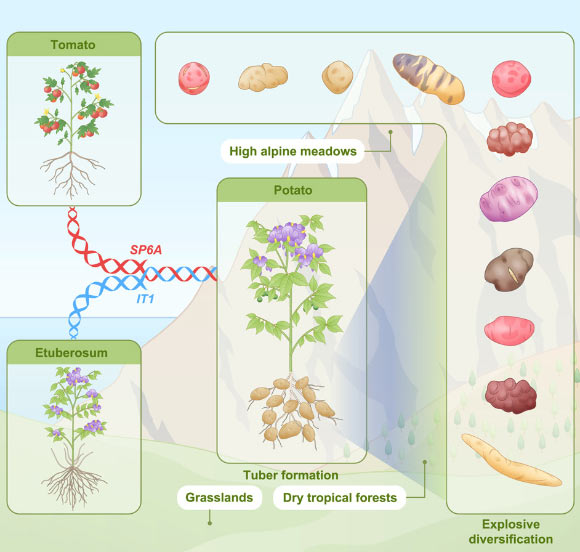Now Reading: Potatoes and Tomatoes Share 8-Million-Year Evolutionary Link, Study Reveals
-
01
Potatoes and Tomatoes Share 8-Million-Year Evolutionary Link, Study Reveals
Potatoes and Tomatoes Share 8-Million-Year Evolutionary Link, Study Reveals

Rapid Summary
- An international team of biologists has identified the evolutionary origins of modern-day potatoes (Solanum tuberosum),linking their growth to hybridization between ancient tomato and potato-like species from South America about 8-9 million years ago.
- Potatoes are a vital global staple crop, ranking third after rice and wheat in terms of caloric contribution to human diets.
- The cultivated potato shares ancestors with three potato-like plants from Chile, called Etuberosum, which do not produce tubers. Potatoes are more closely related to tomatoes in their genetic makeup then these relatives.
- Researchers analyzed 450 genomes of cultivated potatoes and 56 wild species and found that all potatoes carry stable combinations of genetics from both Etuberosum and tomato species.
- Key genes responsible for forming tubers-such as SP6A (from tomatoes) and IT1 (from Etuberosum)-were essential for the evolutionary leap towards nutrient-storing underground structures.
- This innovation coincided with the rise of the Andes Mountains, creating diverse ecological environments that early potatoes adapted to using underground tubers for survival in harsh conditions.
- Tubers enabled rapid reproduction without seeds or pollination, allowing expansion across a range of ecological niches in Central and South America over millions of years.
- Dr. Huang from the Agricultural genomics Institute at Shenzhen noted that hybridization was integral to developing traits seen in modern potatoes.
Indian Opinion Analysis
This discovery is scientifically significant as it exposes how critical hybridization events can drive new biological traits with far-reaching implications. For India-one of the largest producers and consumers of potatoes globally-the study underscores the importance of genetic diversity when improving agricultural resilience against climate challenges.
The research highlights how ancient environmental adaptations enabled certain crops like potatoes to thrive under resource-limited conditions. With contemporary agriculture facing unpredictable weather due to climate change, this study could inspire renewed attention on genetically understanding staple crops’ evolution for better adaptation strategies.Moreover, India’s agricultural scientists might consider deeper cross-disciplinary genomic studies regarding native root-based crops like yams or taro given similar storage benefits they offer under variable climates akin to what historical tuber formation achieved millions of years ago.
























